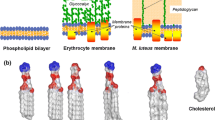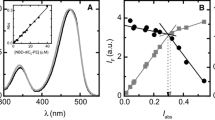Abstract
The macrolide antibiotic azithromycin was shown to markedly inhibit endocytosis. Here we investigate the interaction of azithromycin with biomembranes and its effects on membrane biophysics in relation to endocytosis. Equilibrium dialysis and 31P NMR revealed that azithromycin binds to lipidic model membranes and decreases the mobility of phospholipid phosphate heads. In contrast, azithromycin had no effect deeper in the bilayer, based on fluorescence polarization of TMA-DPH and DPH, compounds that, respectively, explore the interfacial and hydrophobic domains of bilayers, and it did not induce membrane fusion, a key event of vesicular trafficking. Atomic force microscopy showed that azithromycin perturbed lateral phase separation in Langmuir-Blodgett monolayers, indicating a perturbation of membrane organization in lateral domains. The consequence of azithromycin/phospholipid interaction on membrane endocytosis was next evaluated in J774 macrophages by using three tracers with different insertion preferences inside the biological membranes and intracellular trafficking: C6-NBD-SM, TMA-DPH and N-Rh-PE. Azithromycin differentially altered their insertion into the plasma membrane, slowed down membrane trafficking towards lysosomes, as evaluated by the rate of N-Rh-PE self-quenching relief, but did not affect bulk membrane internalization of C6-NBD-SM and TMA-DPH. Azithromycin also decreased plasma membrane fluidity, as shown by TMA-DPH fluorescence polarization and confocal microscopy after labeling by fluorescent concanavalin A. We conclude that azithromycin directly interacts with phospholipids, modifies biophysical properties of membrane and affects membrane dynamics in living cells. This antibiotic may therefore help to elucidate the physico-chemical properties underlying endocytosis.
Similar content being viewed by others
Abbreviations
- C6-NBD-SM:
-
6-((N-(7-nitrobenz-2-oxa-1,3-diazol-4-yl)amino)hexanoyl) sphingosyl phosphocholine
- N- Rh- PE:
-
N-(lissamine rhodamine B sulfonyl) diacyl phosphatidylethanolamine;
- DPH:
-
l,6-diphenyl-l,3,5-hexatriene
- TMA-DPH:
-
1-(4-trimethylammonium-phenyl)-6-phenyl-1,3,5-hexatriene
- Rl8:
-
octadecylrhodamine B
- AFM:
-
atomic force microscopy
- MLV:
-
multilamellar vesicles
- LUV:
-
large unilamellar vesicles
- SUV:
-
small unilamellar vesicles
- DPPC:
-
dipalmitoylphosphatidylcholine
References
Agasosler, A.V., Tungodden, L.M., Cejka, D., Bakstad, E., Sydnes, L.K., Holmsen, H. 2001. Chlorpromazine-induced increase in dipalmitoylphosphatidylserine surface area in monolayers at room temperature. Biochem. Pharmacol. 61:817–825
Asawakarn, T., Cladera, J., O’Shea, P. 2001. Effects of the membrane dipole potential on the interaction of saquinavir with phospholipid membranes and plasma membrane receptors of Caco-2 cells. J. Biol. Chem. 276:38457–38463
Bartlett, G.R. 1959. Phosphorus assay in column chromatography. J. Biol. Chem. 234:466–468
Bastiaanse, E.M., Jongsma, H.J., van derLaarse, A., Takens-Kwak, B.R. 1993. Heptanol-induced decrease in cardiac gap junctional conductance is mediated by a decrease in the fluidity of membranous cholesterol-rich domains. J. Membrane Biol. 136:135–145
Bazzoni, G., Rasia, M. 2001. Effect of tetracaine chlorhydrate on the mechanical properties of the erythrocyte membrane. Blood Cells Mol. Dis. 27:391–398
Bright, G.M., Nagel, A.A., Bordner, J., Desa, K.A., Dibrino, J.N., Nowakowska, J., Vincent, L., Watrous, R.M., Sciavolino, F.C. 1988. Synthesis, in vitro and in vivo activity of novel 9-deoxo-9a-aza-9a-homoerythromycin A derivatives: a new class of macrolide antibiotics, the azalides. J. Antibiot. 41:1029–1047
Carlier, M.-B., Garcia-Luque, I., Montenez, J-P., Tulkens, P.M., Piret, J. 1994. Accumulation, release and subcellular localization of azithromycin in phagocytic and non-phagocytic cells in culture. Int. J. Tiss. Reac. 16:211–220
Cazzalini, O., Lazze, M.C., Lamele, L., Stivala, L.A., Bianchi, L., Vaghi, P., Cornaglia, A., Calligaro, A., Vannini, V. 2001. Early effects of AZT on mitochondrial functions in the absence of mitochondrial DNA depletion in rat myotubes. Biochem. Pharmacol. 62:893–902
Coupin, G., Kuhry, J.-G. 1999. Differentiation between clathrindependent and clathrin-independent endocytosis by means of membrane fluidity measurements. Cell. Biochem. Biophys. 30:25–34
Dai, J., Sheetz, M.P. 1995. Regulation of endocytosis, exocytosis, and shape by membrane tension. Cold Spring Harb. Symp. Quant. Biol. 60:567–571
Djokic, S., Kobrehel, G., Lazarevski, G. 1987. Erythromycin series. XII. Antibacterial in vitro evaluation of 10-dihydro-10-deoxo-l1-azaerythromycin A: synthesis and structure-activity relationship of its acyl derivatives. J. Antibiot. 11:1006–1015
Draye, J.P., Courtoy, P.J., Quintart, J., Baudhuin, P. 1988. A quantitative model of traffic between plasma membrane and secondary lysosomes: evaluation of inflow, lateral diffusion, and degradation. J. Cell Biol. 107:2109–2115
Dufrêne, Y.F., Lee, G.U. 2000. Advances in the characterization of supported lipid films with the atomic force microscope. Biochim. Biophys. Acta 1509:14–41
Düzgünes, N., Allen, T.M., Fedor, J., Papahadjopoulos, D. 1987. Lipid mixing during membrane aggregation and fusion: why fusion assays disagree. Biochemistry 26:8435–8442
Farge, E. 1995. Increased vesicle endocytosis due to an increase in the plasma membrane phosphatidylserine concentration. Biophys. J. 69:2501–2506
Farge, E., Ojcius, D.M., Subtil, A., Dautry-Varsat, A. 1999. Enhancement of endocytosis due to aminophospholipid transport across the plasma membrane of living cells. Am. J. Physiol. 276:C725-C733
Friedlander, G., Le Grimellec, C, Giocondi, M.C., Amiel, C. 1987. Benzyl alcohol increases membrane fluidity and modulates cyclic AMP synthesis in intact renal epithelial cells. Biochim. Biophys. Acta 903:341–348
Gheber, L.A., Edidin, M. 1999. A model for membrane patchiness: lateral diffusion in the presence of barriers and vesicle traffic. Biophys. J. 77:3163–3175
Go, M.L., Feng, S.S. 2001. Halofantrine-phospholipid interactions: monolayer studies. Chem. Pharm. Bull. 49:871–876
Grage, S.L., Gauger, D.R., Selle, C, Pohle, W., Richter, W., Ulrich, A.S. 2000. The amphiphilic drug flufenamic acid can induce a hexagonal phase in DMPC: a solid state P-31 and F-19-NMR study. Phys. Chem. Chem. Phys. 2:4574–4579
Heerklotz, H. 2001. Membrane stress and permeabilization induced by asymmetric incorporation of compounds. Biophys. J. 81:184–195
Hing, A.W., Schaefer, J., Kobayashi, G.S. 2000. Deuterium NMR investigation of an amphotericin B derivative in mechanically aligned lipid bilayers. Biochim. Biophys. Ada 1463:323–332
Hoekstra, D., de Boer, T., Klappe, K., Wilschut, J. 1984. Fluorescence method for measuring the kinetics of fusion between biological membranes. Biochemistry 23:5675–5681
Huijbregts, R.P., Topalof, L., Bankaitis, V.A. 2000. Lipid metabolism and regulation of membrane trafficking. Traffic 1:195–202
Huttner, W.B., Zimmerberg, J. 2001. Implications of lipid microdomains for membrane curvature, budding and fission. Curr. Opin. Cell. Biol. 13:478–484
Illinger, D., Poindron, P., Fonteneau, P., Modollel, M., Kuhry, J.G. 1990. Internalization of the lipophilic fluorescent probe trimethylamino-diphenylhexatriene follows the endocytosis and recycling of the plasma membrane in cells. Biochim. Biophys. Acta 1030:73–81
Illinger, D., Poindron, P., Kuhry, J.-G. 1991. Membrane fluidity aspects in endocytosis; a study with the fluorescent probe trimethylamino-diphenylhexatriene in L929 cells. Biol. Cell 71:293–296
Jutila, A., Soderlund, T., Pakkanen, A.L., Huttunen M., Kinnunen, P.K. 2001. Comparison of the effects of clozapine, chlorpromazine and haloperidol on membrane lateral heterogeneity. Chem. Phys. Lipids 112:151–163
Kaiser, R.D., London, E., 1998. Location of diphenylhexatriene (DPH) and its derivatives within membranes: comparison of different fluorescence quenching analyses of membrane depth. Biochemistry 37:8180–8190
Kitagawa, S., Matsubayashi, M., Kotani, K., Usui, K., Kametani, F. 1991. Asymmetry of membrane fluidity in the lipid bilayer of blood platelets: fluorescence study with diphenylhexatriene and analogs. J. Membrane Biol. 119:221–227
Kok, J.W., ter Beest, M., Scherphof, G., Hoekstra, D. 1990. A non-exchangeable fluorescent phospholipid analog as a membrane traffic marker of the endocytic pathway. Eur. J. Cell Biol. 53:173–184
Koval, M., Pagano, R.E. 1989. Lipid recycling between the plasma membrane and intracellular compartments: transport and metabolism of fluorescent sphingomyelin analogues in cultured fibroblasts. J. Cell Biol. 108:2169–2181
Lowry, O.H., Rosebrough, N.J., Farr, A.L., Randall, R.J. 1951. Protein measurement with the Folin phenol reagent. J. Biol. Chem. 193:265–275
Marsh, M. 2001. Endocytosis. Oxford University Press. Corby, Northants, UK
Mason, R.P., Mak, IT., Trumbore, M.W., Mason, P.E. 1999. Antioxidant properties of calcium antagonists related to membrane biophysical interactions. Am. J. Cardiol. 84:16L-22L
Milhaud, J., Ponsinet, V., Takashi, M., Michels, B. 2002. Interactions of the drug amphotericin B with phospholipid membranes containing or not ergosterol: new insight into the role of ergosterol. Biochim. Biophys. Acta 1558:95–108
Mingeot-Leclercq, M.-P., Gallet, X., Flore, C, Van Bambeke, F., Peuvot, J., Brasseur, R. 2001. Experimental and conformational analyses of interactions between butenafine and lipids. Antimicrob. Agents Chemother. 45:3347–3354
Mingeot-Leclercq, M.P., Schanck, A., Ronveaux-Dupal, M.F., Deleers, M., Brasseur, R., Ruysschaert, J.M., Laurent, G., Tulkens, P.M. 1989. Ultrastructural, physico-chemical and conformational study of the interactions of gentamicin and bis(beta-diethylaminoethylether)hexestrol with negatively charged phospholipid bilayers. Biochem. Pharmacol. 38:729–741
Mingeot-Leclercq, M.P., Tulkens, P.M. 1999. Aminoglycosides: nephrotoxicity. Antimicrob. Agents Chemother. 43:1003–1012
Montenez, J.P., Van Bambeke, F., Piret, J., Brasseur, R., Tulkens, P.M., Mingeot-Leclercq, M.P. 1999. Interactions of macrolide antibiotics (erythromycin A, roxithromycin, erythromycylamine and azithromycin) with phospholipids: computer-aided conformational analysis and studies on acellular and cell culture models. Toxicol. Applied Pharmacol. 156:129–140
Montenez, J.P., Van Bambeke, F., Piret, J., Schanck, A., Brasseur, R., Tulkens, P.M., Mingeot-Leclercq, M.P. 1996. Interaction of the macrolide azithromycin with phospholipids. II. Biophysical and computer-aided conformational studies. Eur. J. Pharmacol. 314:215–227
Morgan, C.G., Williamson, H., Fuller, S., Hudson, B. 1983. Melittin induces fusion of unilamellar phospholipid vesicles. Biochim. Biophys. Acta 732:668–674
Mukherjee, S., Ghosh, R.N., Maxfield, F.R. 1997. Endocytosis. Physiol. Rev. 77:759–803
Mukherjee, S., Maxfield, F.R. 2000. Role of membrane organization and membrane domains in endocytic lipid trafficking. Traffic 1:203–211
Puri, V., Watanabe, R., Singh, R.D., Dominguez, M., Brown, J.C., Wheatley, C.L., Marks, D.L., Pagano, R.E. 2001. Clathrindependent and -independent internalization of plasma membrane sphingolipids initiates two Golgi targeting pathways. J. Cell Biol. 154:535–547
Rauch, C, Farge, E. 2000. Endocytosis switch controlled by transmembrane osmotic pressure and phospholipid number asymmetry. Biophys. J. 78:3036–3047
Raucher, D., Sheetz, M.P. 2001. Phospholipase C activation by anesthetics decreases membrane-cytoskeleton adhesion. J. Cell. Sci. 114:3759–3766
Roberson, M., Neri A., Oppenheimer, S.B. 1975. Distribution of concanavalin A receptor sites on specific populations of embryonic cells. Science 189:639–640
Roth, M.G., Sternweis, P.C. 1997. The role of lipid signaling in constitutive membrane traffic. Curr. Opin. Cell Biol. 9:519–526
Saint-Laurent, A., Boudreau, N., Lariviere, D., Legault, J., Gaudreault, R.C., Auger, M. 2001. Membrane interactions of a new class of anticancer agents derived from arylchloroethylurea: a FTIR spectroscopic study. Chem. Phys. Lipids 111:163–175
Seelig, J. 1978.31P Nuclear magnetic resonance and the head group structure of phospholipids in membranes. Biochim. Biophys. Acta 515:105–140
Snyderman, R., Pike, M.C., Fischer, D.G., Koren, H.S. 1977. Biologic and biochemical activities of continuous macrophage cell lines P 338 Dl and J 774 1. J. Immunol. 119:2060–2066
Sparr, E., Ekelund, K., Engblom, J., Engstreöm, S., Wennerstöm, H. 1999. An AFM study of lipid monoiayers: II. The effect of cholesterol on fatty acids. Langmuir 15:6946–6949
Takei, K., Haucke, V. 2001. Clathrin-mediated endocytosis: membrane factors pull the trigger. Trends Cell Biol. 11:385–391
Tang, Q., Edidin, M. 2001. Vesicle trafficking and cell surface membrane patchiness. Biophys. J. 81:196–203
Tyteca, D., Van DerSmissen, P., Mettlen, M., Van Bambeke, F., Tulkens, P.M., Mingeot-Leclercq, M.P., Courtoy, P.J. 2002. Azithromycin, a lysosomotropic antibiotic, has distinct effects on fluid-phase and receptor-mediated endocytosis, but does not impair phagocytosis in J774 macrophages. Exp. Cell Res. 281: 86–100
Tyteca, D., Van DerSmissen, P., Van Bambeke, F., Leys, K., Tulkens, P.M., Courtoy, P.J., Mingeot-Leclercq, M.P. 2001. Azithromycin, a lysosomotropic antibiotic, impairs fluid-phase pinocytosis in cultured fibroblasts. Eur. J. Cell Biol. 80:466–478
Van Bambeke, F., Mingeot-Leclercq, M.P., Schanck, A., Brasseur, R., Tulkens, P.M. 1993. Alterations in membrane permeability induced by aminoglycoside antibiotics: studies on liposomes and cultured cells. Eur. J. Pharmacol. 247:155–168
Van Bambeke, F., Montenez, J.P., Piret, J., Tulkens, P.M., Courtoy, P.J., Mingeot-Leclercq, M.P. 1996. Interaction of the macrolide azithromycin with phospholipids. I. Inhibition of lysosomal phospholipase Al activity. Eur. J. Pharmacol. 314:203–214
Van Bambeke, F., Tulkens, P.M., Brasseur, R., Mingeot-Leclercq, M.P. 1995. Aminoglycoside antibiotics induce aggregation but not fusion of negatively-charged liposomes. Eur. J. Pharmacol. 289:321–333
Author information
Authors and Affiliations
Corresponding author
Rights and permissions
About this article
Cite this article
Tyteca, D., Schanck, A., Dufrêne, Y.F. et al. The macrolide antibiotic azithromycin interacts with lipids and affects membrane organization and fluidity: Studies on langmuir-blodgett monolayers, liposomes and J774 macrophages. J. Membrane Biol. 192, 203–215 (2003). https://doi.org/10.1007/s00232-002-1076-7
Received:
Revised:
Issue Date:
DOI: https://doi.org/10.1007/s00232-002-1076-7




